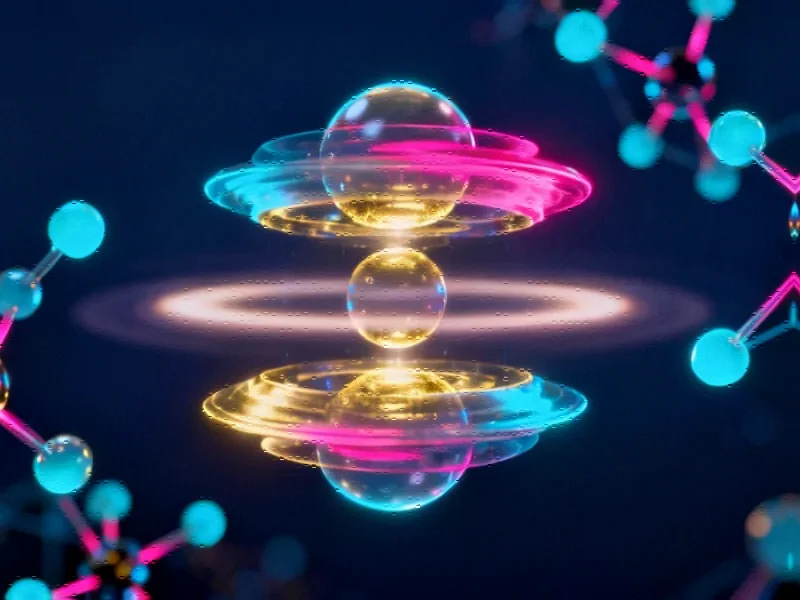Revolutionizing Materials Discovery Through Molecular Descriptors
Researchers have developed a groundbreaking computational approach that dramatically accelerates the discovery of fluorescence emitters with inverted singlet-triplet (IST) energy gaps. This innovative method, detailed in npj Computational Materials, utilizes a sophisticated four-orbital model to identify key molecular characteristics that enable the development of highly efficient organic light-emitting diodes (OLEDs), particularly in the near-infrared spectrum.
The research team established two crucial molecular descriptors—KS and ΔD—that enable rapid screening of potential IST materials from vast chemical databases. This represents a significant advancement in computational materials science, reducing screening time by 13 times while maintaining an impressive 90% success rate compared to traditional post-Hartree-Fock calculations.
Understanding the IST Energy Gap Mechanism
The investigation began with analyzing twelve molecular models—eight known IST molecules and four conventional positive singlet-triplet (PST) gap systems. Through advanced computational methods including B3LYP/cc-pVDZ geometry optimization and ADC(2)/cc-pVDZ excited-state analysis, researchers identified the critical factors driving IST formation.
“The key insight emerged from understanding how ultra-small HOMO-LUMO orbital overlaps combine with significant energy differences in double excitation orbitals to create negative ΔEST values,” explained the research team. This fundamental understanding enabled the development of their breakthrough computational method for materials discovery.
The Four-Orbital Model Framework
At the heart of this discovery lies the carefully constructed four-orbital model focusing on HOMO-1, HOMO, LUMO, and LUMO+1 orbitals. The model incorporates both single and double electron excitation processes, with the research team identifying eight sets of double excitations for singlet states and four for triplet states.
Through Hartree-Fock theory and configuration interaction calculations, the team demonstrated that the total energy gap depends critically on the competition between positive exchange integrals from single excitations and negative contributions from double excitations. This delicate balance determines whether a molecule exhibits the coveted IST property essential for high-performance OLED applications.
Molecular Descriptors for High-Throughput Screening
The KS descriptor quantifies the spatial overlap between HOMO and LUMO orbitals, with values below 0.400 eV indicating favorable conditions for IST formation. Meanwhile, the ΔD descriptor captures the energy characteristics of orbitals involved in double excitations, requiring values below -3.000 eV for IST candidates.
These descriptors enabled the team to rapidly screen 3,486 azaphenalene derivatives, identifying 41 promising IST cores. The efficiency of this approach represents a quantum leap in materials discovery, aligning with recent industry developments in chemical innovation and computational efficiency.
Practical Application and Validation
The research team implemented a comprehensive three-step workflow for practical application:
- Database Establishment: Generating and optimizing 3,486 molecular structures, resulting in 3,156 stable configurations after frequency analysis
- Descriptor Screening: Applying KS and ΔD criteria to identify 338 potential IST candidates
- Computational Verification: Confirming final IST molecules using EOM-CCSD/cc-pVDZ and SC-NEVPT2(8,8)/cc-pVDZ methods
This systematic approach demonstrates how advanced computational techniques are transforming materials discovery pipelines across multiple industries.
Near-Infrared OLED Applications
Perhaps the most exciting aspect of this research is the prediction of non-traditional near-infrared IST materials from a dataset of 1,028 compounds. These materials exhibit significantly enhanced intersystem crossing rates from T1 to S1 states and superior radiative rates compared to previously discovered systems.
The successful identification of these materials marks the first time IST compounds have been proposed as near-infrared OLED emitters, opening new possibilities for temperature-driven technological applications in sensing, communication, and medical imaging.
Industry Implications and Future Directions
This computational breakthrough arrives at a crucial time for the display and lighting industries, where demand for efficient near-infrared emitters continues to grow. The methodology’s efficiency and accuracy suggest it could become a standard tool for materials scientists working on next-generation electronic devices and optoelectronic applications.
Furthermore, the research team has made their Python code for computing KS and ΔD descriptors publicly available, enabling broader adoption of their methodology. This transparency accelerates collective progress in the field, much like related innovations in biomedical research that benefit from open computational tools.
The combination of theoretical insight, practical computational tools, and demonstrated screening success positions this research as a landmark achievement in computational materials design, with far-reaching implications for electronics, photonics, and energy-efficient lighting technologies.
This article aggregates information from publicly available sources. All trademarks and copyrights belong to their respective owners.
Note: Featured image is for illustrative purposes only and does not represent any specific product, service, or entity mentioned in this article.



